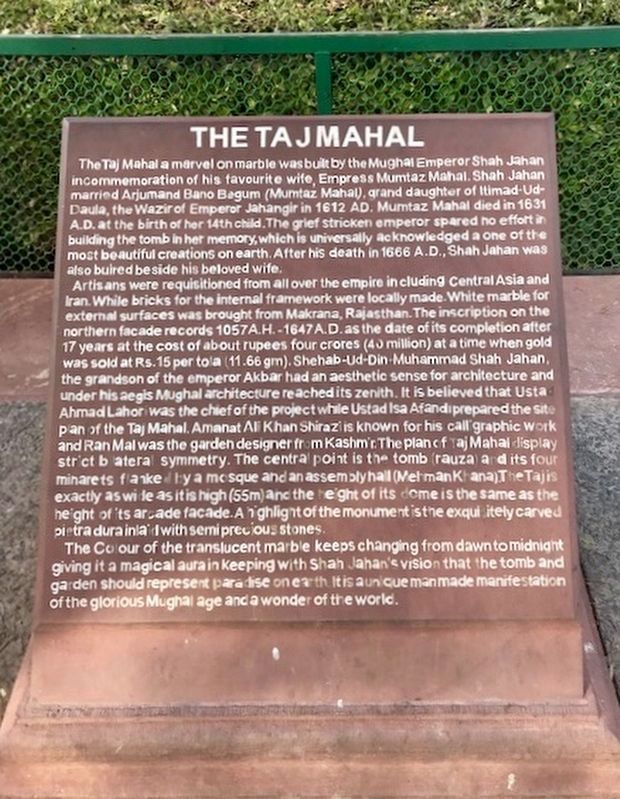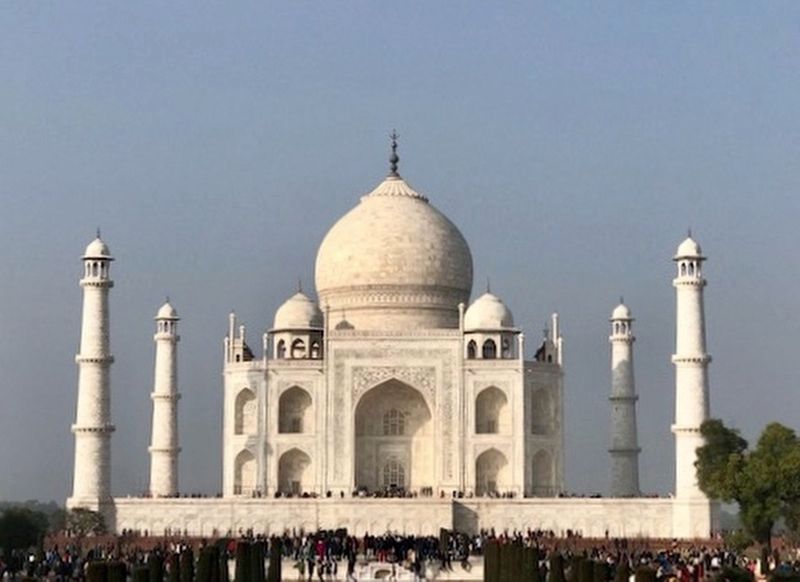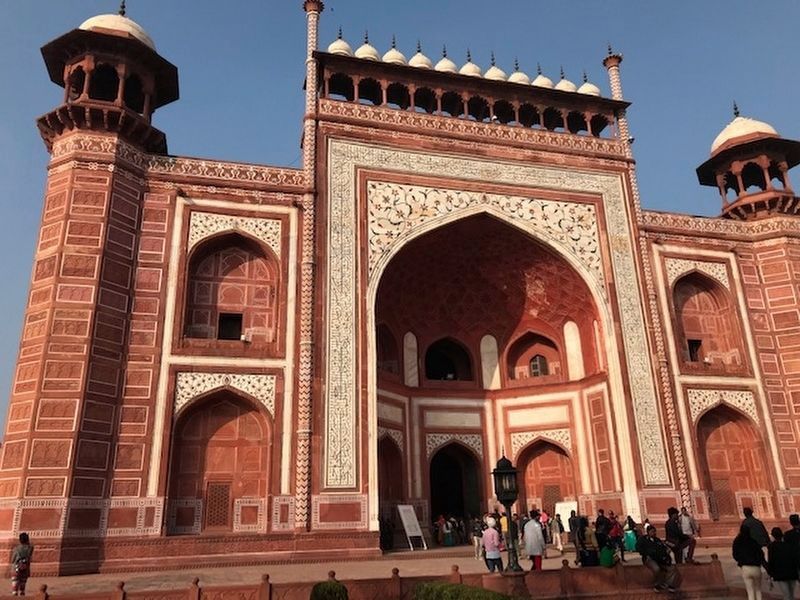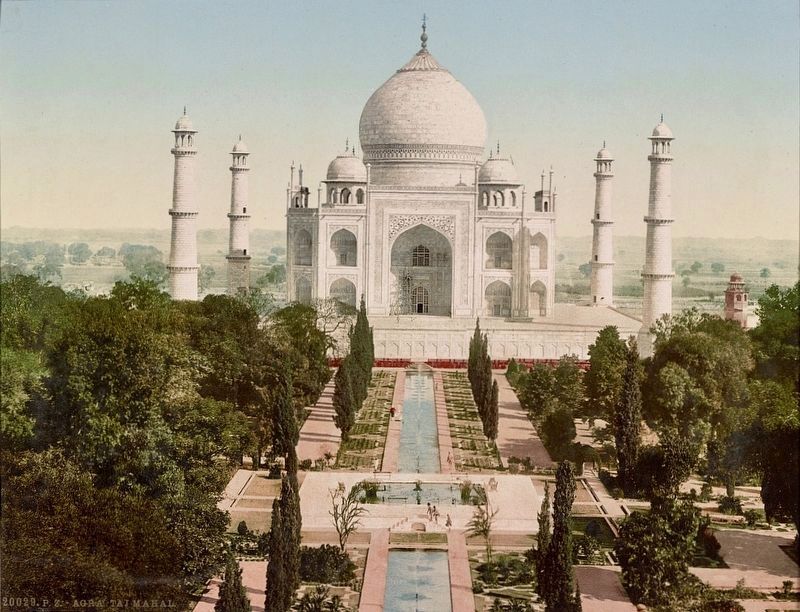Agra in Agra District, Uttar Pradesh, India — भारत (South Asia)
The Taj Mahal
The Taj Mahal a marvel on marble was built by the Mughal Emperor Shah Jahan in commemoration of his favourite wife, Empress Mumtaz Mahal. Shah Jahan married Arjumand Bano Bagum (Mumtaz Mahal), grand daughter of I'timad-Ud- Daula, the Wazir of Emperor Jahangir in 1612 AD. Mumtaz Mahal died in 1631 A.D. at the birth of her 14th child. The grief stricken emperor spared no effort in building the tomb in her memory, which is universally acknowledged as one of the most beautiful creations on earth. After his death in 1666 A.D., Shah Jahan was also buried beside his beloved wife.
Artisans were requisitioned from all over the empire including Central Asia and Iran. While bricks for the internal framework were locally made. White marble for external surfaces was brought from Makrana, Rajasthan. The inscription on the northern facade records 1057 A.H. - 1647 A.D.as the date of its completion after 17 years at the cost of about rupees four crores (40 million) at a time when gold was sold at Rs. 15 per tola 11.66 gm). Shehab-ud-Din Muhammad Shah Jahan, the grandson of the emperor Akbar had an aesthetic sense for architecture and under his aegis Mughal architecture reached its zenith. It is believed that Usta Ahmad Lahor was the chief of the project while Ustad Isa Afandi prepared the site plan of the Taj Mahal. Amanat Al Khan Shirazi is khown for his calligraphic work and Ran Mal was the garden designer from Kashmir. The plan of Taj Mahal display strict bilateral symmetry. The central point is the tomb (rauza) and its four minarets flanked by a mosque and an assembly hall (Mehman Kana). The Taj is exactly as wide as it is high (55m) and the height of its dome is the same as the height of its arcade facade. A highlight of the monument is the exquisitely carved pietra dura inlaid with semiprecious stones.
The Colour of the translucent marble keeps changing from dawn to midnight giving it a magical aura in keeping with Shah Jahan's vision that the tomb and garden should represent paradise on earth. It is a unique manmade manifestation of the glorious Mughal age and a wonder of the world.
Topics. This historical marker is listed in these topic lists: Architecture • Cemeteries & Burial Sites. A significant historical year for this entry is 1612.
Location. 27° 10.282′ N, 78° 2.516′ E. Marker is in Agra, Uttar Pradesh, in Agra District. Touch for map. Marker is in this post office area: Agra, Uttar Pradesh 28200-1, India. Touch for directions.
More about this marker. The marker is located in the forecourt of the Taj Mahal, just outside the Great Gate. The marker is inscribed on a low marble monument abutting a low green fence, just to the west of the lane in the middle that leads to the Great Gate entrance.
Also see . . .
1. Taj Mahal. Wikipedia entry:
The Taj Mahal (lit. Crown of the Palace) is an ivory-white marble mausoleum on the south bank of the Yamuna river in the Indian city of Agra. It was commissioned in 1632 by the Mughal emperor Shah Jahan (reigned from 1628 to 1658) to house the tomb of his favourite wife, Mumtaz Mahal; it also houses the tomb of Shah Jahan himself. The tomb is the centrepiece of a 17-hectare (42-acre) complex, which includes a mosque and a guest house, and is set in formal gardens bounded on three sides by a crenellated wall.... The Taj Mahal was designated as a UNESCO World Heritage Site in 1983 for being "the jewel of Muslim art in India and one of the universally admired masterpieces of the world's heritage". It is regarded by many as the best example of Mughal architecture and a symbol of India's rich history. The Taj Mahal attracts 7–8 million visitors a year and in 2007, it was declared a winner of the New7Wonders of the World (2000–2007) initiative." (Submitted on January 20, 2020.)
2. Taj Mahal. Government of India website homepage (Submitted on January 20, 2020.)
Credits. This page was last revised on October 27, 2021. It was originally submitted on January 20, 2020, by Andrew Ruppenstein of Lamorinda, California. This page has been viewed 549 times since then and 41 times this year. Photos: 1, 2, 3, 4. submitted on January 20, 2020, by Andrew Ruppenstein of Lamorinda, California.



